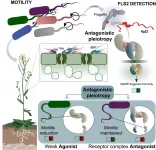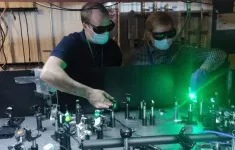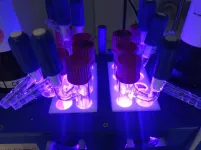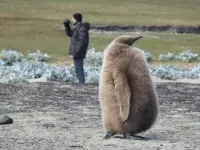When synthetic evolution rhymes with natural diversity
2021-03-25
(Press-News.org) Researchers at GMI - Gregor Mendel Institute of Molecular Plant Biology of the Austrian Academy of Sciences, the University of North Carolina at Chapel Hill and The Howard Hughes Medical Institute (HHMI) use two complementary approaches to unveil a co-evolutionary mechanism between bacteria and plants and also explain complex immune response patterns observed in the wild. Together the papers change the way scientists have been thinking about the relationship of a bacterial antigenic component with its plant immune receptor. The two papers are published back to back in the journal Cell Host & Microbe.
Immune responses have developed in virtually all organisms over evolutionary time scales to protect them from foreign invaders. A central aspect of the immune response of higher organisms, i.e., plants and animals, is the use of sensory systems that detect and respond to "non-self" molecular signals. These molecular signals generally determine the survival chances of the pathogen, a factor that prevents them from being eliminated by natural selection as a means to evade host recognition. Their evolutionary conservation is thus due to the functionality of these molecular signals to the foreign invader. However, the negative evolutionary pressure to maintain this functionality is counterbalanced by the positive evolutionary pressure to mediate the pathogen's immune evasion. The dissection of these co-evolutionary forces through synthetic and reverse evolutionary methods is one of the two research approaches that researchers from the Belkhadir lab at GMI and the Dangl lab at UNC- Chapel Hill team up to investigate. In an orthogonal approach, they also inquire into the natural diversity of molecular antigenic determinants (epitopes) in plant-colonizing bacterial communities (commensal communities) and map the complex immune response patterns they trigger in the plants. Jeffery Dangl, John N. Couch Distinguished Professor at UNC-Chapel Hill and an HHMI investigator explains: "To date, most science in this field has used a handful of epitopes. We sampled thousands, derived from synthetic biology and commensal communities. This depth of analysis allowed us to uncover a rich diversity of host response mediated by a single receptor."
Reverse evolution and new insights on co-evolution
The researchers examine how the Arabidopsis immune sensor FLS2 (flagellin sensing 2) influenced the evolution of its interacting epitope on the Pseudomonas flagellin, and how this, in turn, influenced Pseudomonas motility. Using reverse evolutionary methods, Parys et al. uncover a new mechanism of co-evolutionary force between FLS2 and flagellin, and frame it as a molecular form of the scarcely studied theory of antagonistic pleiotropy (AP) in plant immunology. AP is the ability of a gene to induce opposing effects in different contexts, a prevailing theory for the evolutionary origin of aging in humans. The researchers demonstrate that AP fosters stable colonization of Arabidopsis by commensal communities by weighing out bacterial motility against sensor detection. This strategy results in flagellin epitopes that either mildly activate or outright block the receptor (gain in virulence), while losing in motility as a trade-off (loss in virulence). Even more excitingly, they find signatures of these synthetic experiments in naturally occurring commensal communities, suggesting that natural microbiomes might be less dependent on flagella-mediated motility and willing to trade it off against another form of immune evasion in order to stay in harmony with the plant.
Friend or foe?
In the second, natural sampling approach, Colaianni et al. demonstrate that immune evasion mechanisms in plant root commensal communities are rampant and are a determining factor of the community's structure. Moreover, this conceptual breakthrough is accompanied by the corroborating findings of complex immune response fine-tuning mechanisms in Arabidopsis. The diversity of the ligand epitopes is translated in a complexity of the immune responses engaged by the plant, which is capable of detecting threshold variations in its microbiome, and thus, discriminating between "friend and foe."
On immune evasion and plant growth promotion
Asked about possible applications of this joint work, GMI group leader Youssef Belkhadir elaborates: "Sometimes, it is good to know how to turn on an immune response, but we often forget that, sometimes, it might also be good to turn it off. For example, you could help a growth-promoting microbe better colonize the plant by providing it with an additional way to evade the plant's immune response. And here we discovered synthetic antagonistic peptides that could do just that."
Back to the (plant) roots
This collaboration draws on an exchange in expertise between the alternating first authors of the two publications, but also refreshes long-dating, outstanding, scientific contacts. In fact, Nicholas Colaianni, Ph.D. student in the Dangl lab at UNC-Chapel Hill, is a computational expert, whereas the main fields of expertise of Katarzyna Parys (former Ph.D. student in the Belkhadir lab) lie in biochemistry and wet lab genetics. Colaianni also visited the Belkhadir lab at GMI and both he and Parys benefited from hands-on training in each other's field of expertise. In addition, as a third co-first author on both publications, Ho-Seok Lee, postdoctoral fellow in the Belkhadir lab, contributed his skills in microscopy imaging.
After many years of separate research, the two main principal investigators who share seniority and alternate corresponding authorships on the two publications, decided to make a comeback together. The shared seniority also includes Corbin Jones, Biology Professor at UNC-Chapel Hill and Colaianni's co-mentor. Youssef Belkhadir is a UNC-Chapel Hill alumnus who worked with Jeffery Dangl as a Ph.D. student. Referring to the UNC Tar Heels basketball team that Dangl loves, Belkhadir says "17 years after I co-authored my first paper with Jeff, it was a lot of fun to get on the court and 'slam-dunk' it with him once more!". Dangl adds "Just like basketball, science is a team effort and the best teams play fluidly together."
An international consortium
GMI and UNC-Chapel Hill share a deep commitment to international collaboration and the present work rallied an international consortium of scientists spearheaded by Youssef Belkhadir, including the University of Geneva and the University of Lausanne in Switzerland, the Max Perutz Labs of the University of Vienna in Austria and the University of Würzburg in Germany. The researchers also acknowledge the contribution of the Vienna Biocenter member institutes and facilities.
INFORMATION:
Original publications:
Parys et al., "Signatures of antagonistic pleiotropy in a bacterial flagellin epitope", Cell Host & Microbe, 2021. DOI: https://doi.org/10.1016/j.chom.2021.02.008
Colaianni et al., "A complex immune response to flagellin epitope variation in commensal communities", Cell Host & Microbe, 2021. DOI: https://doi.org/10.1016/j.chom.2021.02.006
[Attachments] See images for this press release:

ELSE PRESS RELEASES FROM THIS DATE:
2021-03-25
LOS ALAMOS, N.M., March 25, 2021--A new class of quantum dots deliver a stable stream of single, spectrally tunable infrared photons under ambient conditions and at room temperature, unlike other single photon emitters. This breakthrough opens a range of practical applications, including quantum communication, quantum metrology, medical imaging and diagnostics, and clandestine labeling.
"The demonstration of high single-photon purity in the infrared has immediate utility in areas such as quantum key distribution for secure communication," said Victor Klimov, lead author of a paper published ...
2021-03-25
Opioids are the main driver of fatal drug overdoses in the United States, according to the Centers for Disease Control and Prevention, resulting in 46,802 deaths in 2018, usually because the person stops breathing.
Naloxone -- a Food and Drug Administration-approved medication used to reverse overdoses from opioids, such as heroin, morphine and oxycodone -- works by restoring normal respiration to a person whose breathing has slowed or stopped.
"Opioid overdoses cause the largest number of accidental and avoidable deaths," said Peter Davidson, PhD, associate professor in the Department of Medicine at University of California San Diego School of Medicine. "The human toll of drug addiction is devastating. Using naloxone to prevent opiate overdoses can and has saved many lives."
In ...
2021-03-25
A major goal of organic and medicinal chemistry in recent decades has been the rapid synthesis of three-dimensional molecules for the development of new drugs. These drug candidates exhibit a variety of improved properties compared to predominantly flat molecular structures, which are reflected in clinical trials by higher efficacy and success rates. However, they could only be produced at great expense or not at all using previous methods. Chemists led by Prof. Frank Glorius (University of Münster, Germany) and his colleagues Prof. M. Kevin Brown (Indiana University Bloomington) and Prof. Kendall N. Houk (University of California, Los Angeles) have now succeeded in converting several classes of flat ...
2021-03-25
Skoltech scientists and their colleagues have proposed a new human height inheritance model that accounts for the interaction between various factors that influence adult human height. The research was published in the European Journal of Human Genetics.
Human height is a classical quantitative trait that depends on sex, genetics, and the environment.
Scientists from Skoltech, Novosibirsk State University, the Institute of Cytology and Genetics of the Siberian Branch of RAS, and the Institute of Science and Technology in Vienna analyzed the human height distribution ...
2021-03-25
Buried beneath 20 kilometers of ice, the subsurface ocean of Enceladus--one of Saturn's moons--appears to be churning with currents akin to those on Earth.
The theory, derived from the shape of Enceladus's ice shell, challenges the current thinking that the moon's global ocean is homogenous, apart from some vertical mixing driven by the warmth of the moon's core.
Enceladus, a tiny frozen ball about 500 kilometers in diameter (about 1/7th the diameter of Earth's moon), is the sixth largest moon of Saturn. Despite its small size, Enceladus attracted the ...
2021-03-25
About two decades after first devising a new kind of vaccine, Oregon Health & Science University researchers are unlocking why it stops and ultimately clears the monkey form of HIV, called SIV, in about half of nonhuman primates - and why it's a promising candidate to stop HIV in people.
In scientific papers that were simultaneously published today in the journals Science and Science Immunology, creators of the cytomegalovirus, or CMV, vaccine platform describe the unusual biological mechanisms through which it works.
The findings also helped fine-tune VIR-1111, the CMV-based experimental vaccine against HIV that was developed at OHSU and is now being evaluated in a Phase 1 clinical trial. The trial is being conducted by Vir Biotechnology, which ...
2021-03-25
SILVER SPRING, Md. - As concern has grown over COVID-19 variants and their implications for how well COVID-19 vaccines will protect against the virus, researchers have proposed a method to examine instances of SARS-COV-2 infections in people who have received a COVID-19 vaccine.
Genomic sieve analysis of these so-called "breakthrough" SARS-CoV-2 infections in COVID vaccine trials is a critical tool to identify viral mutations associated with vaccine failure and to predict how vaccination impacts the virus' evolution.
Dr. Morgane Rolland, Chief of Viral Genetics ...
2021-03-25
Scientists at Sinai Health say they have discovered a new pathway that controls dangerous overreactions in a body's immune system, including deadly forms of hyper-inflammation.
In new findings out today in the journal Science, researchers at the Lunenfeld-Tanenbaum Research Institute (LTRI) detail how a protein known as WAVE2, a protein expressed in all immune cells, plays a critical role in maintaining immune system balance.
As part of the research, scientists knocked out, or turned off, WAVE2 in a subset of immune cells in mice, which led to severe autoimmunity and inflammation, ...
2021-03-25
Despite having remarkable utility in treating movement disorders such as Parkinson's disease, deep brain stimulation (DBS) has confounded researchers, with a general lack of understanding of why it works at some frequencies and does not at others. Now a University of Houston biomedical engineer is presenting evidence in Nature Communications Biology that electrical stimulation of the brain at higher frequencies (>100Hz) induces resonating waveforms which can successfully recalibrate dysfunctional circuits causing movement symptoms.
"We investigated the modulations in local ?eld potentials induced by electrical stimulation of the subthalamic nucleus (STN) at therapeutic ...
2021-03-25
Tel-Aviv, ISRAEL - March 25, 2021 - Wild Biotech, a preclinical stage drug discovery & development company emerging out of stealth mode, today announces the publication of its first major paper, which appears in the journal Science. The study mapped the gut microbiota of animals in the wild on an unprecedented scale, adding millions of potentially novel microbiome-based therapeutics for human diseases to the company's already massive database. Wild will use these findings to first tap its database for targets in inflammatory, immune and gastrointestinal diseases.
"For the study, we collected gut microbiota from almost 200 species of animals in the wild, covering diverse classes, feeding behaviors, geographies, and ...
LAST 30 PRESS RELEASES:
[Press-News.org] When synthetic evolution rhymes with natural diversity






